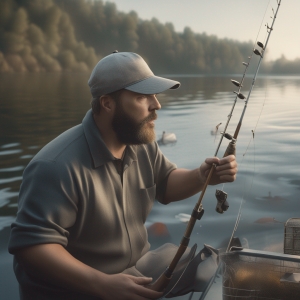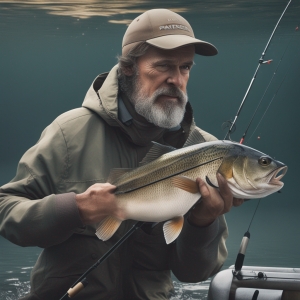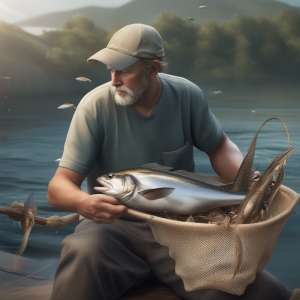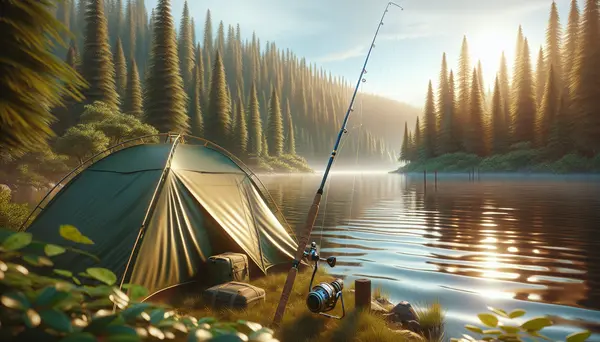Table of Contents:
Introduction to Fishing for Beginners
One of the most simple yet satisfying outdoor activities anyone can engage in, is fishing. In this article, we've dedicated our time to helping beginners navigate the waters of this tranquil sport. Regardless of if your fishing excursions are a solo escape, family bonding time, or a fun hangout with friends, learning how to fish will enrich your life in various unexpected ways. For beginners, fishing might seem puzzling at first, but fear not, our introduction to fishing for beginners is here to turn you into a regular angler in no time.
Choosing the Right Equipment
Kicking off your fishing journey begins with getting the right equipment. While the process might seem overwhelming, you can breathe easy knowing it's simpler than you think. There are three main equipment elements needed; a fishing rod, fishing line, and hooks. Picking a fishing rod is your first step. Beginners are advised to start with a medium strength rod to support different fishing styles. The second element, the fishing line, typically comes with your fishing rod. However, ensure it's sturdy and can hold up to a minimum of 14 pounds. Lastly, the hooks. Smaller hooks are ideal for beginners as they work with a variety of fish species. Remember, the right equipment prepares you for a rewarding fishing experience.
Pros and Cons of Fishing for Beginners
| Pros | Cons |
|---|---|
| Can be a budget-friendly hobby | Requires patience, which might be difficult for some |
| Opportunity to connect with nature | Could be harmful to the environment if not done responsibly |
| Provides a sense of achievement | May involve long periods of inactivity |
| Teaches self-reliance | Requires knowledge about different types of fishing and fish species |
| Can be a relaxing leisure activity | Bad weather can ruin fishing plans |
Understanding Basic Fishing Practices

The essential part of your fishing journey lies in learning the fundamental fishing practices. This simplifies the process and gives you a higher chance of success when you're out on the water.
Firstly, understanding how to cast a fishing line is crucial. Use your forearm to swing the rod forward while releasing the line with your opposite hand. Practice this motion to increase your accuracy and distance over time.
Secondly, feel for a bite. This requires patience and a keen sense of touch. When a fish strikes, you’ll feel a slight tug on your fishing rod. But wait, don’t reel in yet! Ensure the fish has taken your bait fully before you start to pull back.
And finally, the art of reeling in. Reel in slowly while keeping your rod tip lifted. If the fish takes off, let it. Don’t break the line. When the fish gets tired, it’s your chance to reel it in fully.
Mastering these basic practices isn’t accomplished in a day, so give yourself some time, and soon, you’ll be fishing like a pro.
Hook, Line and Sinker: The Art of Casting
One crucial element that could make or break your fishing experience is the act of casting. This movement, seemingly simple, is a ballet of timing, coordination, and precision. The casting technique is what connects you, the angler, to the watery world below where fish reside.
To begin, you hold the rod correctly, grasp it so your hand is just above the reel, with your index finger extended along the rod. This stance gives you more control and precision during the process.
Next, focus on the swing. You aim, swing back slowly, and then snap forward in a smooth controlled movement. Aim to have your bait or lure land gently on the water. Achieving the perfect cast is a delicate balance between power and control. It's not about how far you can throw, but rather how accurately you can place your bait where the fish are.
Practice makes perfect, they say. And casting is no exception. Start practicing in open areas before heading off to the water. Mastering this process might be challenging at first, but once you do, your successful casts will feel rewarding and significantly increase your chances of landing a catch.
Patience and Timing: When to Fish

It's worth stating that a successful fishing expedition isn't instant. Alongside patience, timing plays a key role in determining your fishing success. Therefore, it's important to know when exactly to head out for a fishing session.
The best times to fish are usually early morning or late evening as fish are more active during these cooler periods of the day. This is due to the fact that fish tend to feed more at a time that's suitable for catching.
Apart from daily timing, lunar phases also significantly affect fish activity. Many successful anglers swear that fishing during a full moon or new moon period increases chances of a good catch due to increased fish activity.
Weather changes, such as the transition from a sunny day to an overcast one, can also contribute to more active fish and, consequently, more bites. Moreover, seasons also influence fish activity. Depending on the fish species, certain seasons will yield a greater catch. Consult local anglers, fishing guides or online resources to understand the right season for different fish in your area.
Thus, fishing isn't just a game of throwing the line into the water at any given time. It's a strategy—part of which is understanding the best times to fish. So, be ready to embrace patience, and spend time learning about fish habits and timing to improve your fishing experiences olver time.
Reeling in: Your First Catch
The thrill of feeling that first tug on your line is an exhilarating sensation that every angler cherishes. It's the first sign that your patience and planning are about to pay off. However, how you handle this moment will determine whether your first catch is a success or a learning experience.
Once the fish has taken your bait and you've set the hook it's time to start the exciting process of reeling in. The key to reeling in your catch is maintaining a consistent level of tension on the line. This ensures that the hook remains securely in place whilst warding off the attempts of the fish to escape.
Commence by bringing in the line carefully, keeping the rod tip up and maintaining constant pressure. Fight the urge to reel frantically. It isn’t a speed competition. Instead, focus on the rhythm. Resist the fight from the fish by pulling back the rod and when the tension decreases, reel in the slack line.
Remember, reeling in too aggressively can result in either the hook dislodging or the line breaking, both of which will leave you fishless. On the other hand, too little tension might give the fish an opportunity to spit out the hook and swim away. That's why achieving the right balance is essential.
Take into consideration that larger fish can be particularly challenging to reel in. In cases like this, the “pump and reel” technique proves useful. This involves lifting the rod tip up and then lowering it as you reel in the slack. Repeat this process until your quarry is near and ready to be brought ashore.
Your first catch will be a memorable experience, and reeling in with diligence and patience will ensure it's a successful one. Don't be discouraged if your initial attempts don't lead to success immediately. Every seasoned angler understands that fishing is a journey of constant learning and improving.
The Ethics of Fishing: Catch and Release

Fishing, as a sport or hobby, requires a sense of purpose and respect towards the environment. This brings us to a key ethical principle in the world of angling — catch and release. This practice not only ensures the sustainability of fish populations, but also maintains the balance of the aquatic ecosystem.
As a beginner, it's essential to master the right technique to catch and release. First, handle your catch carefully. Always wet your hands before touching the fish to protect its delicate skin and scales. Remember, the goal is to return the fish to the water as healthy as when it was caught.
Second, remove the hook gently and swiftly to cause as little distress as possible. Tools such as hook removers or needle-nose pliers can simplify this process. Should the fish be hook-swallowed, it's often better to cut the line as close to the hook as possible rather than attempt a damaging extraction
Finally, return the fish to the water. Allow the fish to acclimate by holding it upright in the water and gradually let it swim away. In all circumstances, ensure that the process is rushed as little as possible and that the fish is well taken care of.
By adopting the catch and release process, you contribute to preserving the future of our fisheries and ensuring that future generations can enjoy the thrill of fishing just as you do.
Conclusion: Starting Your Fishing Journey
Embarking on your fishing journey, equipped with the right knowledge and tools, prepares you for a remarkable experience. Remember, fishing goes beyond merely catching fish; it's an opportunity to connect with nature, find tranquility, and even develop patience and resilience. As a beginner, the journey might seem slightly intimidating, but with time and practice, you'll grow into a confident angler.
Embrace every learning opportunity, absorb as much knowledge as possible, remain patient and stay committed to the process. The thrill of catching your first fish will be a moment to cherish and a validation of your hard work and perseverance. So, gather your equipment, step into your fishing boots, cast your line, and embrace the peaceful world of fishing. Your adventure awaits!
Essential Tips for Fishing Beginners
What equipment do I need for fishing as a beginner?
As a beginner, you need a basic fishing rod, fishing line, hooks, baits and a fishing net. It's also advisable to carry a first aid kit and some additional fishing gear like floats and sinkers.
How do I choose the right fishing rod?
Choosing the right fishing rod depends on the type of fishing you intend to do. Rods differ in length, weight, flexibility, material and price. For beginners, a medium strength, flexible, and easy-to-handle rod is usually the best choice.
How do I attach the hook and bait?
First, thread the line through the rod's guides from the reel to the tip. Then, tie the hook onto the line using a suitable knot. The type of bait used depends on the fish species, but you typically thread or loop the bait onto the hook.
What is a good fishing spot for beginners?
Good fishing spots for beginners are places with calm water and plenty of fish. Public ponds, lakes, or rivers with piers or jetties are great starting points. Local fishermen or fishing reports can help identify good fishing spots in your area.
What is the best time to go fishing?
The best time to go fishing typically depends on the fish species, but generally, early morning and late evening are the most productive times of day. Fish often feed more actively during these periods.







